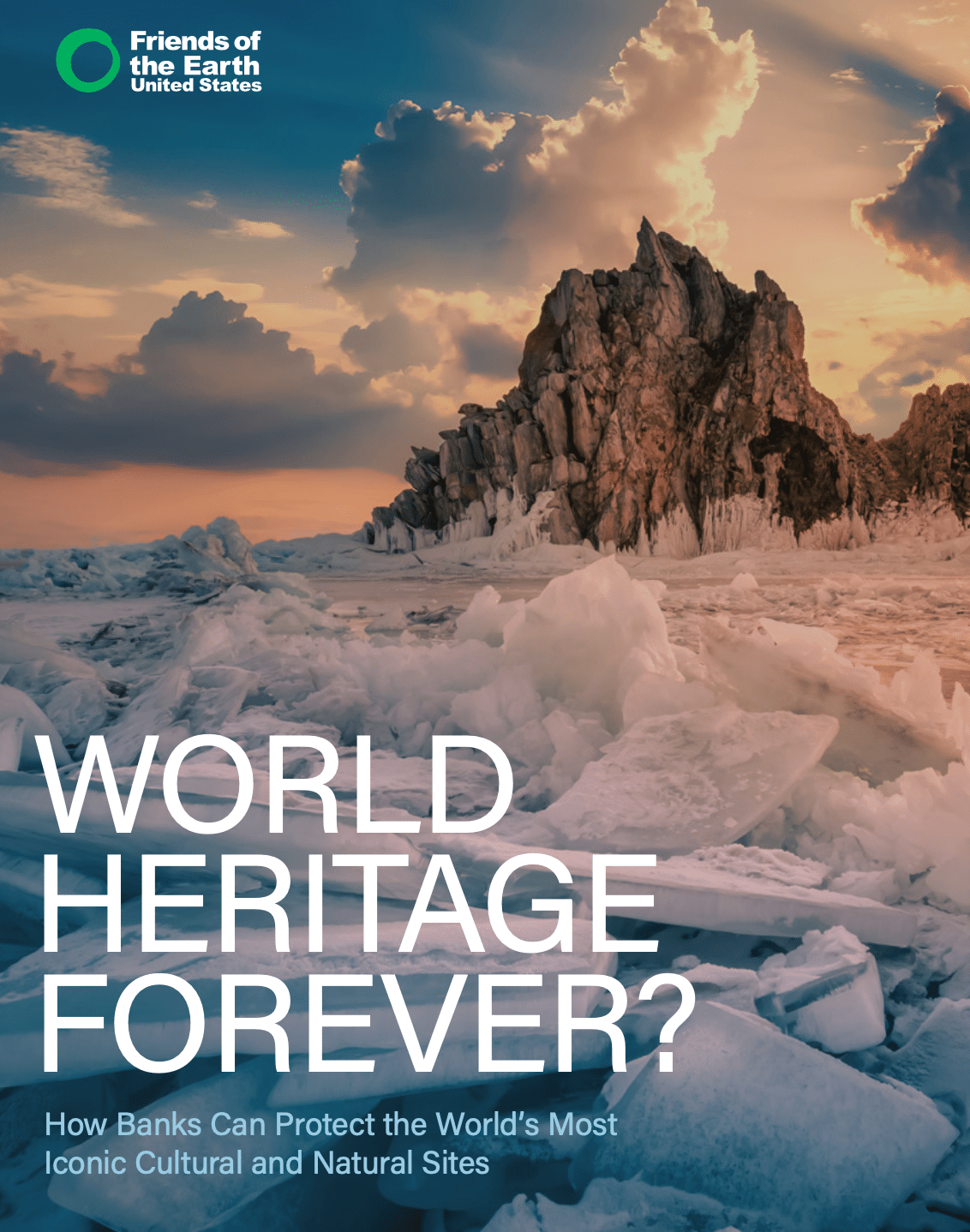World Heritage Forever? How Banks Can Protect the World’s Most Iconic Cultural and Natural Sites

Friends of the Earth US has published a new report, “World Heritage Forever? How Banks Can Protect the World’s Most Iconic Cultural and Natural Sites”, examining how the international banking sector lacks strong policies and practices to protect World Heritage and other internationally recognized sites. Drawing on six case studies, the report calls on financial institutions to adopt the Banks and Biodiversity No Go policy, which advocates that banks prohibit direct and indirect financing to harmful activities which may negatively impact internationally recognized areas.
In light of the twin crises of biodiversity loss and climate change, protecting areas which are already recognized for their exceptional biodiversity and climate regulatory value is more important than ever. At the same time, the most biodiverse places left in the world now overlap with Indigenous Peoples and local communities. This also underscores why banks should require ensuring free, prior, informed consent in their financing. However, banks have yet to develop consistent, comprehensive policies and practices to actively preempt harmful financing in some of the most iconic places on Earth. Unfortunately, even the most prestigious World Heritage sites are not adequately shielded from harmful financing.
Key Findings
- Multilateral, public, private sector, and Chinese banks have yet to develop consistent and comprehensive policies to safeguard internationally recognized areas, such as World Heritage sites
- Multilateral, public, private sector, and Chinese banks should prohibit indirect and direct financing to activities which negatively impact internationally recognized areas, such as World Heritage sites, even if not directly located in the site proper
- Multilateral, public, private sector, and Chinese banks should require free, prior, informed consent
- Multilateral, public, private sector, and Chinese banks all struggle to adequately implement environmental and social safeguards and policies
- Despite international prestige and recognition, internationally recognized areas face recurring risks, sometimes across decades, from harmful development activities
- Negative environmental and social impacts may be triggered or exacerbated by ill-conceived project locations
- Conversely, negative environmental and social impacts can be preempted by prohibiting projects located in internationally recognized and sensitive areas
- Banks should adopt the Banks and Biodiversity Initiative’s No Go policy, which outlines eight broad areas where banks should prohibit harmful direct and indirect financing
Case Studies
Case studies in this report include the following examples which impact World Heritage, Ramsar, Biosphere, IUCN category sites.
| Project | Sector | Country | Impacted Areas |
|
Mongolian Dams and Lake Baikal |
Hydropower |
Mongolia |
Lake Baikal, World Heritage site |
|
Oil Development in Yasuní National Park |
Oil Development |
Ecuador |
Yasuní Biosphere Reserve IUCN category II site |
|
Iron Ore Mining in Mount Nimba |
Mining |
Guinea |
Mount Nimba, World Heritage site |
|
Palm Oil and the Tropical Rainforest Heritage of Sumatra |
Palm Oil |
Indonesia |
Tropical Rainforest Heritage of Sumatra, World Heritage site |
|
LNG Development in the Quirimba Biosphere Reserve |
Liquified Natural Gas |
Mozambique |
Quirimbas Biosphere Reserve |
|
East African Crude Oil Pipeline and Protected Areas |
Oil Infrastructure |
Uganda & Tanzania |
Burigi-Biharamulo Game Reserves, IUCN Cat IV Ngorongoro National Park, World Heritage site Murchison Falls-Albert Delta Wetland System, Ramsar site Lutembe Bay Wetland System, Ramsar site Taala Forest Reserve, Ugandan protected area Bugoma Forest, Ugandan protected area Pemba-Shimoni-Kisite Reserve, marine protected area Tanga Coelacanth Marine Park, marine protected area Wembere Steppe, Key Biodiversity Area |
Banks play a critical role in ensuring protected areas stay protected, and there is growing international agreement in this regard. The World Heritage Committee “strongly encourages [sic] all banks, investment funds, the insurance industry and other relevant private and public sector companies to integrate into their sustainability policies, provisions for ensuring that they are not financing projects that may negatively impact World Heritage properties and that the companies they are investing in subscribe to the ‘No-go commitment’”. And according to Intergovernmental Science-Policy Platform on Biodiversity and Ecosystem Services (IPBES), “A key component of sustainable pathways is the evolution of global financial and economic systems to build a global sustainable economy, steering away from the current, limited paradigm of economic growth”.
Accomplishing this will not be easy. But it will be worthwhile. With the looming challenges of biodiversity loss and climate change, it is more important than ever if we are able to keep our world – and World Heritage – forever.
Ways to Support Our Work

Read Latest News
Stay informed and inspired. Read our latest press releases to see how we’re making a difference for the planet.

See Our Impact
See the real wins your support made possible. Read about the campaign wins we’ve fought for and won together.

Donate Today
Help power change. It takes support from environmental champions like you to build a more healthy and just world.